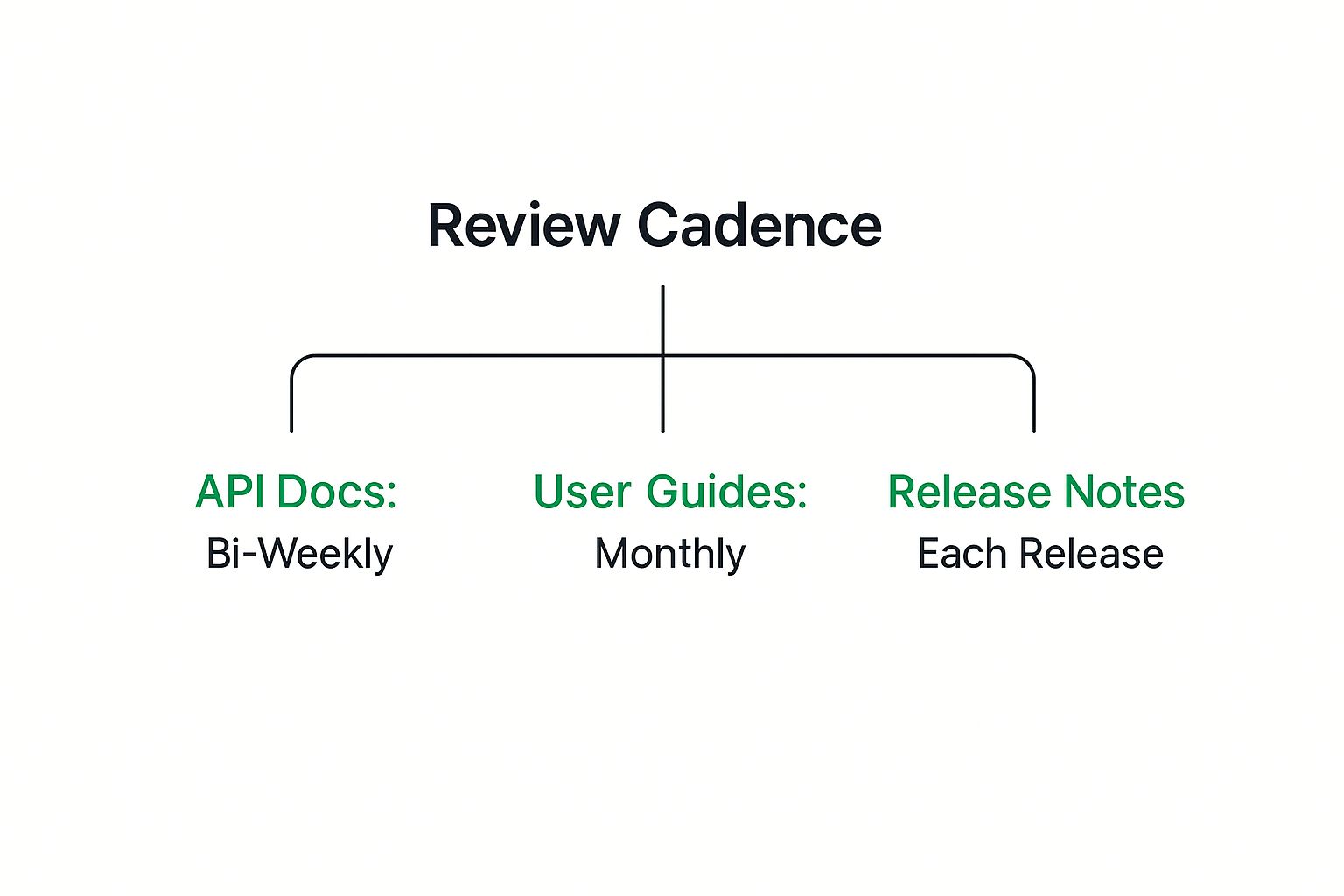Master documentation maintenance with proven strategies that keep code and API docs accurate. Learn from teams who've transformed their workflows.

Imagine stumbling upon documentation that looks fantastic at first glance. It seems comprehensive, covering everything you need. Then you try a code sample…and it breaks. Or you test an API endpoint…and it’s dead. This, sadly, is the reality of many a “digital graveyard.” Documentation, once vibrant and useful, becomes misleading, frustrating, and ultimately, worthless. And that’s not just annoying; it has real consequences for organizations.
Outdated documentation is more than a minor inconvenience. Think about the impact on trust within your development team. When engineers can’t rely on their own internal resources, their productivity takes a nosedive. They’re forced to waste precious time debugging broken examples or desperately searching for updated information. This leads to project delays and skyrocketing frustration. Onboarding new team members becomes a nightmare, too. Instead of hitting the ground running, they’re stuck deciphering ancient texts, hindering their ability to contribute effectively.
Catching the early signs of documentation decay is key to avoiding a full-blown crisis. A spike in support tickets related to confusing or incorrect documentation is a major red flag. Increased internal chatter, with developers constantly asking each other for help or workarounds, is another telltale sign. Also, keep a close eye on code changes that aren’t reflected in the documentation. This disconnect creates a widening gap between the actual system and its documented counterpart. Think of it like a map that hasn’t been updated to reflect new roads and changed landscapes - eventually, it becomes useless. While the field of documentation maintenance is constantly evolving, core principles remain relevant. Just as data-driven approaches, using metrics like Mean Time to Repair (MTTR), are crucial for optimizing industrial maintenance processes Discover more insights on maintenance industry trends., using metrics and analytics in document management ensures its effectiveness and keeps it aligned with reality.
Maintaining good documentation requires a proactive strategy, not a reactive one. It’s about building systems and processes that prevent decay before it starts. This means integrating documentation updates directly into the development workflow. Just as code goes through rigorous testing, documentation should be reviewed and updated alongside every code change. This keeps it accurate and prevents it from becoming detached from the systems it describes. This integrated approach to documentation maintenance essentially creates a “living document” that stays relevant and valuable throughout a project’s lifecycle. It eliminates the frustration and wasted time associated with outdated information, and it builds a culture of trust and efficiency within the development team.
The key to maintaining effective documentation isn’t about writing more of it, but writing smarter documentation. Think of it like building a house: a solid foundation and flexible design allows for future renovations without tearing everything down. This same principle applies to your code documentation. We’ll explore how successful open-source projects and enterprise teams create resilient documentation architecture, allowing their docs to adapt gracefully as their code changes.
The trick to writing maintainable documentation lies in focusing on the “why” and the “what,” not the “how.” Implementation details are always changing, but the fundamental purpose of a function or API usually stays the same. For example, instead of documenting the specific steps within an algorithm, concentrate on the desired outcome and the necessary inputs. This approach makes your documentation less vulnerable to becoming outdated with every code adjustment. For a deeper dive, check out our guide on code documentation best practices.
Weaving documentation updates directly into your development workflow is essential. Treat documentation changes with the same level of importance as code changes. Just as code undergoes rigorous testing and review, your documentation should also be reviewed and updated alongside any code modifications. This prevents documentation from becoming disconnected from the system it describes. Neglecting regular updates is like skipping routine maintenance on your car – eventually, things will break down. Understanding why good documentation goes stale can be illuminated by looking at the importance of consistent website maintenance.
Regular reviews are crucial for healthy documentation. Different types of documentation will benefit from different review frequencies. The infographic below illustrates a sample review cadence, breaking down the suggested frequency for various types of documentation.

This visualization shows how prioritizing more frequent reviews for rapidly changing documentation, like API docs, compared to monthly reviews for user guides, ensures the most important resources stay accurate and current. This focused approach helps teams use their documentation maintenance time efficiently.
Real-world examples offer invaluable lessons. Some open-source projects, for example, boast documentation that has gracefully weathered years of code changes. By studying their tactics, like modular documentation and clear versioning, we gain practical insights. Conversely, understanding why some documentation becomes obsolete after a single sprint helps us avoid common pitfalls.
The following table summarizes some common strategies for maintaining documentation. It compares different approaches, considering factors such as the required effort, the resulting accuracy, and the ideal team size for each strategy.
Documentation Maintenance Strategies Comparison A comprehensive comparison of different approaches to maintaining documentation, including their effectiveness, resource requirements, and ideal use cases
This table highlights how different strategies suit different needs. While ad-hoc updates might work for small projects, larger teams benefit from more structured approaches like continuous integration or a dedicated documentation team. This allows them to maintain a higher level of accuracy. This comparative analysis provides valuable lessons for building documentation that stands the test of time. Combined with a proactive mindset, it ensures your documentation remains a valuable resource, not a neglected afterthought.

Let’s be honest, keeping documentation up-to-date often ends up at the bottom of the to-do list. It’s not a matter of laziness or skill; the issue is more about human nature, how we’re incentivized, and how we prioritize when things get busy. We’re naturally drawn to tasks with quick, visible results.
There’s a real sense of satisfaction in launching a new feature. Updating documentation? Not so much.
Our minds are constantly juggling competing priorities. When deadlines approach and the pressure builds, we instinctively gravitate towards tasks with immediate, visible results. Completing a new feature provides a sense of accomplishment, a tangible win you can point to. Maintaining documentation, however, feels more like preventative maintenance. Its benefits aren’t as obvious in the short term.
This is where concepts like present bias come into play. We tend to overvalue immediate rewards and undervalue long-term benefits, even when the long-term benefits are much bigger. For more on this, check out our guide on documentation in Agile development.
Traditional performance reviews often worsen the problem. Developers are typically measured on features shipped, bugs squashed, and lines of code written. Documentation rarely factors into the equation. This creates a system where updating documentation feels like an added chore, something to squeeze in if there’s time – which there almost never is. To ensure your documentation stands the test of time, following best practices is essential. A good starting point is reviewing these technical documentation best practices.
The answer isn’t to make developers feel bad. It’s about realigning incentives. Organizations that get this right recognize the value of good documentation and reward people who contribute to it. This could involve acknowledging documentation efforts in performance reviews, building documentation quality into sprint goals, or even providing small rewards for maintaining it. The key is to make documentation maintenance feel valued, not an afterthought.
Ultimately, great documentation comes from a supportive environment. When teams see documentation as an essential part of development, not a separate chore, maintenance becomes a natural part of the process. This means fostering open communication about documentation needs and challenges, and providing developers with the right tools and the time they need to keep it current. By shifting the mindset from obligation to shared responsibility, organizations create a positive feedback loop where good documentation becomes the norm, not the exception.
Imagine software that seamlessly keeps your code documentation perfectly up-to-date. Sounds fantastic, right? But we’ve all seen the “magical” documentation tools that end up gathering dust in the software graveyard. This section explores practical automation strategies that actually work, drawing on real-world experiences.
Let’s be clear: automation isn’t a magic bullet. Crafting engaging narratives or explaining tricky concepts still needs a human touch. However, plenty of tedious, error-prone documentation tasks are perfect for automation. Think of CI/CD integration as a good starting point. Simple scripts can automatically flag broken code examples or outdated API endpoints before they hit production, saving you headaches down the line.
Taking automation a step further, some systems generate documentation directly from code comments. These tools pull out specially formatted comments and transform them into “living documentation” that evolves with your codebase. This approach eliminates the manual slog of updating separate documentation files, ensuring everything stays consistent and reducing the risk of discrepancies.
Documentation automation tools come in all shapes and sizes. On one end, you have lightweight tools for specific tasks like spell checking or link validation. On the other end, comprehensive platforms manage the entire documentation lifecycle, from writing and review to publishing and version control. The market for these systems is booming. The global document management systems market, valued at ****24.91 billion by 2032. This growth reflects the increasing importance of efficient document management. In fact, 77% of businesses are expanding their use of document management software to improve processes and boost their bottom line. Discover more insights on document management statistics.
Finding the right automation tools is like finding the right shoes – it depends on your needs and what you’re doing. A small team on a simple project might just need basic CI/CD integration. A larger organization with complex products might require a more robust platform like Confluence or Document360. Be realistic about the capabilities and limitations of different tools. Many over-promise and under-deliver, adding complexity instead of simplifying things.
Automation isn’t about replacing human writers. It’s about giving them superpowers. Let automation handle the tedious tasks, freeing up writers to focus on what they do best: explaining complex ideas clearly, adding insightful context, and making documentation engaging. The best automation strategies enhance, not replace, human involvement. They create a partnership where humans and machines work together to produce high-quality, maintainable documentation.

Imagine a team where documenting code is as second nature as breathing. Not a far-fetched dream, but a reality for teams who recognize the vital role of well-maintained documentation. This isn’t just about ticking boxes; it’s about building a shared understanding and a culture where documentation thrives. Let’s explore how to cultivate this “documentation thinking” within your team.
Effective documentation maintenance is like tending a garden – it requires consistent, small efforts. Think about version control with Git. It’s not an afterthought; it’s interwoven into the development process. Similarly, documentation updates should be a natural extension of every code change. When a developer squashes a bug or adds a shiny new feature, updating the relevant documentation should be the next logical step. This prevents documentation from becoming that dusty, forgotten corner of the project.
Imagine this: you’re adding a new function to your codebase. As you commit your changes, you also update the documentation explaining how this new function works and how to use it. It’s a small change with a big impact.
Picture this: a single person burdened with all the documentation. A bottleneck forms, updates slow down, and frustration builds. High-performing teams avoid this scenario by distributing the responsibility. The developer building the feature is also best equipped to document it. This not only spreads the workload, but also ensures the documentation is accurate and reflects the latest changes.
Think of it like a relay race: each team member carries the documentation baton for their part of the project, ensuring a smooth and efficient handover.
Many organizations have successfully transformed their documentation culture. A key ingredient? Leadership that champions documentation. When managers prioritize and reward documentation efforts, it sends a powerful message. This could be anything from showcasing excellent documentation during team meetings to incorporating documentation quality into performance reviews. These small actions can create a culture where everyone values clear, up-to-date documentation.
Even the best documentation can have hidden flaws, like a broken link or an outdated example. How do you catch these? Feedback loops. These could be automated checks, like using a link checker, or simply encouraging team members to flag issues. Tools like Mindstamp can also provide valuable insights into how users are interacting with your documentation. Making feedback visible, especially to those who control resources, is key.
Sustainable documentation comes down to empowering your team. Provide them with the tools, the training, and the time to create and maintain high-quality documentation. Clear guidelines, training on best practices, and integrating documentation tasks into sprints are all essential. When teams have the support they need, documentation transforms from a chore to a valuable asset, fostering communication, collaboration, and knowledge sharing.
To help measure the effectiveness of your documentation maintenance, consider tracking key metrics. The following table outlines some important metrics to consider:
This table helps illustrate how tracking specific metrics can provide valuable insights into the health and effectiveness of your documentation maintenance efforts. By monitoring these KPIs, you can identify areas for improvement and ensure your documentation remains a valuable resource.
Imagine your software documentation as a bustling city. A small town, with a few key roads, is easy to manage. But as the city grows, you need more than just paved streets – you need a comprehensive roadmap, traffic signals, and maybe even a public transportation system. That’s what scaling documentation feels like. What works for a small team can quickly become overwhelming as your organization expands.
This section explores how to scale your documentation maintenance practices without creating overly complex processes that slow everyone down. We’ll look at real-world examples and strategies for balancing quality documentation with the need to move quickly.
Picture a team of five. Documentation is often organic and informal, like sharing directions with a friend. Now, imagine fifty, or even five hundred developers. Suddenly, consistency becomes essential. Establishing clear documentation standards is like creating a common language. It guides contributors without being overly restrictive. Think of it as a style guide, not a rigid set of rules. It should cover key elements like code commenting conventions, API documentation formats (Swagger is a popular choice), and the overall structure of user guides.
It’s not about stifling creativity; it’s about ensuring everyone speaks the same language. This way, when a new developer joins, they can quickly find their way around the “city” of your documentation.
As teams multiply, communication can become tricky. Coordinating documentation efforts across different groups, each with its own priorities, requires a structured approach. One effective strategy is creating a documentation guild or working group. This cross-functional team represents different stakeholders and ensures everyone agrees on documentation standards and processes. They also help share knowledge and find areas for improvement. It’s like establishing a city council to make sure all the different neighborhoods work together.
Maintaining quality at scale requires a strong governance framework. This means defining clear roles and responsibilities. Who’s in charge of each “district” of the documentation? Who reviews and approves changes? A structured approach to quality assurance is also crucial. This might involve automated checks for broken links, outdated code examples, or inconsistencies in style. It’s like having a dedicated team of inspectors making sure everything is up to code. Tools like Vale can help automate style and consistency checks.
Documentation is a living, breathing entity. As your organization grows, so should your documentation systems. Implement tools and processes that encourage knowledge sharing. This could be a central documentation repository, a knowledge base platform, or even regular documentation reviews. Think of it as creating a city library and encouraging everyone to contribute. This fosters continuous improvement and ensures your documentation remains relevant and valuable. As discussed in this resource, good architectural documentation has a ripple effect throughout a project, impacting everything from maintenance and development to team communication and knowledge transfer.
Finally, think about implementing frameworks designed for documentation growth. These might include modular documentation systems that allow for easy updates and version control, such as Read the Docs. Or you could explore automated documentation generation tools, like Doxygen or JSDoc, that pull information directly from your code. These approaches reduce manual effort and ensure consistency, making documentation maintenance less of a headache, even for large, complex projects. They’re like building a smart city infrastructure that can adapt and grow with the population.
This section offers a practical guide to transform your documentation from a headache into a helpful resource. Think of it as your roadmap to documentation success. We’ll cover immediate fixes, building a system for the future, and fostering a culture of documentation within your team. Each step includes ways to measure success and realistic timelines so you can build momentum without feeling overwhelmed. We’ll also look at how to sequence changes for the biggest impact, track progress, and create practices that keep your documentation useful for years to come. This plan has been tested and proven to deliver results.
This blueprint divides documentation maintenance into three phases:
Let’s dive into the specifics for each phase:
Phase 1: Immediate Improvements
Phase 2: System Building